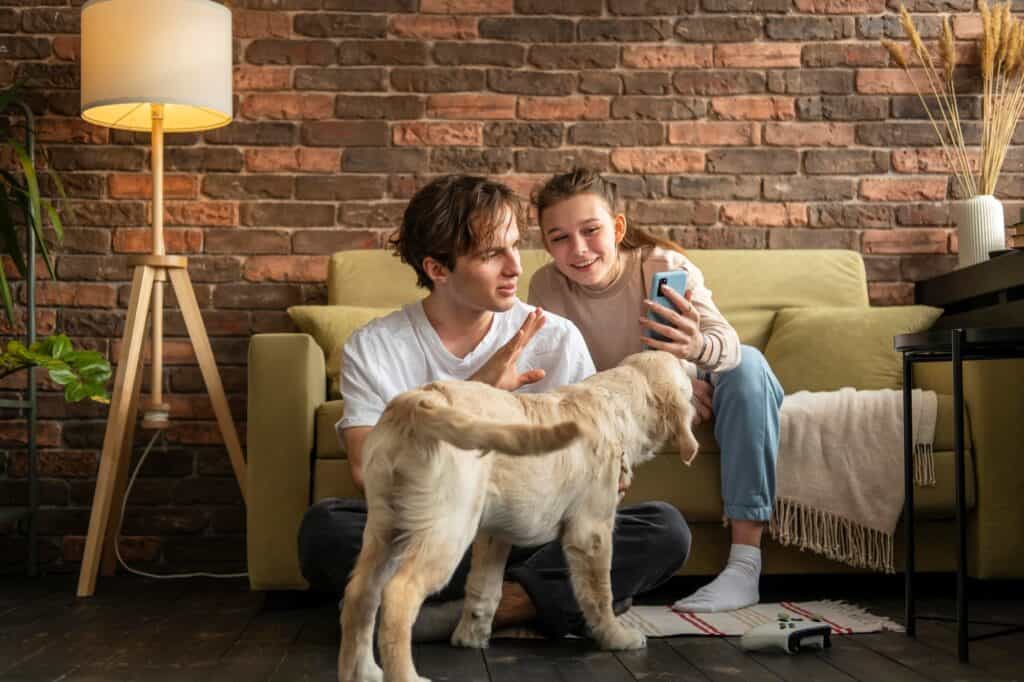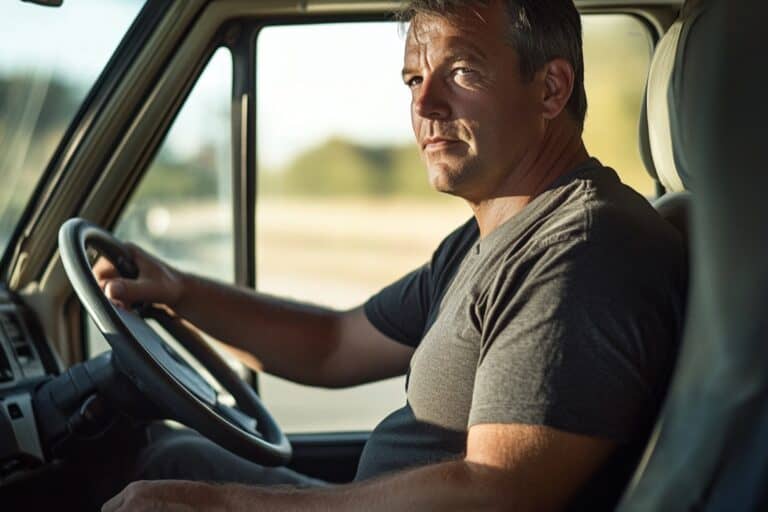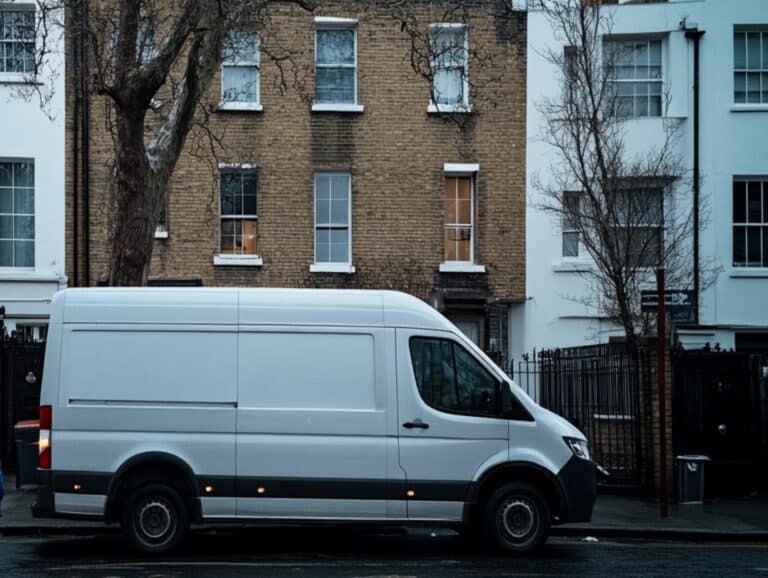Moving house with pets comes with unique challenges. Managing pet transportation when moving house is crucial to ensure your pets are safe and comfortable. In this article, you’ll find practical advice on planning, health checks, choosing the right carrier, ensuring comfort during transit, and settling them into their new home.
Key Takeaways
- Planning and preparation for pet transportation should begin 2-4 months in advance to ensure pets’ safety and comfort during the move.
- Choosing the right pet carrier and familiarising pets with it can significantly reduce travel anxiety and ensure a comfortable transit.
- Post-move care, including registering with a local vet and gradually introducing pets to their new home, is essential for their well-being and adjustment.
Planning for a Smooth Transition
Detailed and early preparation is essential for a stress-free moving experience with pets. Starting early can significantly reduce the complexities involved. Start planning at least 2-4 months in advance to ensure you have ample time to address every aspect of your pet’s needs. This period allows you to make informed decisions about catteries, kennels, or leaving pets with friends or family, ensuring their safety and comfort during the move.
Recognising the unique needs of your pets is vital for their well-being. Pets, sensitive to changes and their owners’ emotions, can experience heightened anxiety during a move. Maintaining routines and familiarising pets with the moving process can minimise their stress. Early preparation helps create a predictable and secure environment, easing the transition.
Different types of pets, whether cats, dogs, small mammals, or exotic animals, require tailored preparations for pet owners to ensure their comfort and safety.
We will explore detailed steps to help manage pet transportation effectively, beginning with necessary health checks and documentation.
Vet Visits and Health Checks
Before moving, schedule a vet visit to ensure your pets are in good health and can handle the travel. Your vet can provide necessary vaccinations and an animal health certificate, especially for international moves, along with advice to reduce your pet’s anxiety and address health concerns.
Updating your pet’s microchip information and ID tags with your new address and contact details is vital for their safety and can help ensure a safe return if they get lost.
Updating Pet Identification
Ensuring your pet’s microchip details and ID tags are updated with your new address and contact information is crucial. These measures can be lifesavers if your pet gets lost during the transition. These small steps can significantly enhance your pet’s safety and comfort during the move.
Preparing Travel Documentation
For international pet moves, having the correct travel documentation, including pet passports and health certificates, is essential. Dogs, cats, and ferrets require a pet passport that includes health information and proof of vaccinations. Start early to avoid last-minute hassles due to processing times.
Choosing the Right Pet Carrier
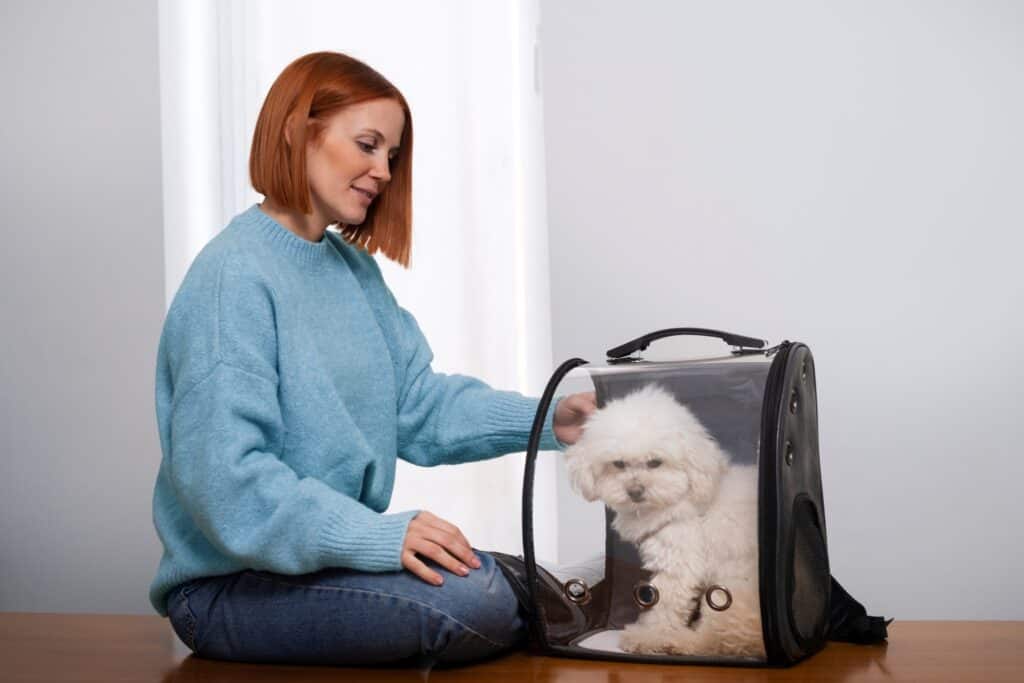
Choosing the right pet carrier is crucial for your pet’s safety and comfort during the move. The carrier should be spacious, well-ventilated, have a secure locking system, and be made of durable materials such as canvas, nylon, or polyester.
Introducing your pet to the carrier well in advance can help reduce anxiety. Place the carrier in a familiar room, encourage exploration by placing treats or toys inside, and take your pet on short, enjoyable drives to get them accustomed to moving conditions. Making the carrier a positive and familiar space can greatly reduce your pet’s stress during transit.
Size and Material Considerations
Size and material are key considerations when choosing a pet carrier. It should allow enough room for your pet to stand, turn, and lie down comfortably. Durable and easy-to-clean materials such as canvas, nylon, and polyester are recommended. Proper ventilation is essential to keep the air fresh and reduce stress levels.
Familiarisation with Carriers
Familiarising your pet with their carrier before the move can greatly reduce anxiety. Place the carrier in a familiar room, encourage exploration with treats or toys, and take short, enjoyable drives to help them get used to moving conditions.
Making the carrier more inviting with familiar scents and items, such as a blanket or toy, can help your pet feel at ease. Gradual introduction and creating a positive space ensure a smoother and more comfortable journey for your pet.
Ensuring Pet Comfort During Transit
Ensuring pet comfort is essential for a smooth transition during a move. Changes in the environment and disrupted routines can cause trauma and the pet’s anxiety. Preparing crates, toys, blankets, food, and water, along with using calming products like pheromones, can ease this stress.
Maintaining normal routines during the move can significantly reduce anxiety levels in pets. Consult your vet about potential anxiety or sickness and consider pet-friendly accommodations for long-distance moves.
Packing Familiar Items
Packing familiar items like toys and blankets provides comfort and security for pets during transit. Acquainting pets with their carriers beforehand helps them associate the carrier with safety, reducing anxiety. Familiar items can make pets feel more at ease in a new environment and lower stress levels.
Acquainting pets with their carriers beforehand helps them associate the carrier with safety …
Providing a secure space for rest during the journey can help alleviate anxiety. Access to favourite items can make the transition to the new home less overwhelming.
Managing Motion Sickness
Managing motion sickness is important for a stress-free move. Avoiding heavy meals before travel and keeping the vehicle well-ventilated can help prevent pets from feeling nauseous.
Implementing these straightforward measures can greatly enhance your pet’s comfort throughout the move. By focusing on their needs, you can ensure a smoother transition and reduce any stress associated with the change in environment.
Managing Different Types of Pets
Different pets have unique needs that must be addressed for safe transport. Understanding these requirements is essential for effective pet transportation.
Ensuring the comfort and safety of different types of pets requires unique considerations throughout the moving process, especially when moving house with pets, to prioritise pet’s comfort.
Cats
Transporting cats requires careful planning. Here are some important considerations:
- A secure travel carrier is crucial for their safety.
- Keep cats indoors for around six weeks after moving to help them adjust.
- Ensure fences, railings, and locks in the new home are in good condition to prevent escapes.
Pheromone diffusers can create a calming environment for your cat during the move. Including bedding or a favourite toy in the travelling box can help them feel secure, aiding a smooth transition to their new home.
Dogs
When moving house with dogs, quickly create a familiar environment in your new house. Set up a designated space with their bed, toys, and essentials to help them feel secure. Allow dogs to explore their new surroundings at their own pace, providing reassurance and familiar items to help them adjust.
Small Pets and Exotic Animals
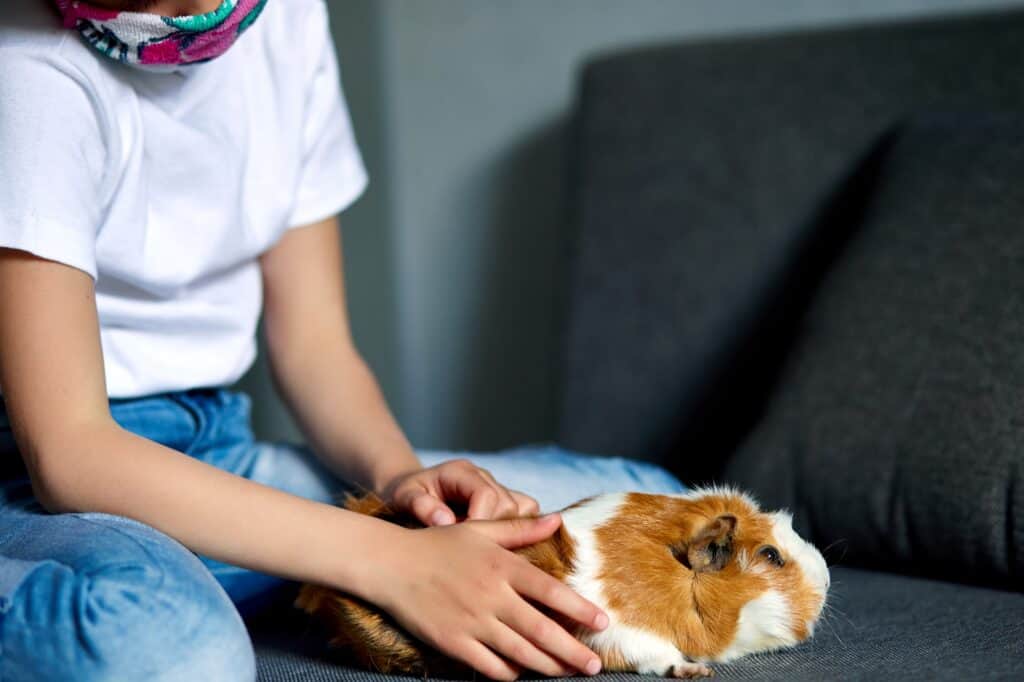
Small pets and exotic animals need special attention during a move. Maintaining habitat stability is crucial for small mammals and birds. Exotic pets may exhibit unique stress responses, such as agitation and feather plucking, requiring specific management techniques. Proper preparation and handling are essential for their well-being during the transition.
Fish
Transporting fish involves specific safety steps. Empty and clean the tank using a syphon hose, then place the fish in a transport container filled with tank water, ensuring enough air for breathing. Wrap the fish tank with packing paper and bubble wrap, positioning it upright during transport to prevent breakage, ensuring your fish arrive safely at their new home.
Settling Pets into Their New Home in North London
Helping pets settle into their new home in North London involves creating a secure space and maintaining routines. Establishing a quiet area with familiar items can help pets cope with the chaos of moving and adjust to their new surroundings. Maintaining your pet’s routine after moving provides stability and comfort.
Creating a Safe Space
Setting up a quiet den area helps pets feel secure. Provide a specific room or crate with their bed, toys, and essentials, including familiar items like favourite toys and blankets, to create comfort. Introducing pets to their den area undisturbed allows them to relax and build confidence. Gradually let them explore the rest of the house once they feel comfortable in their safe space.
Maintaining Routines
Consistent routines provide stability and comfort to pets during the move. Regular feeding and exercise schedules help pets feel more grounded and secure in their new environment. Consistency minimises stress and helps pets adapt more smoothly to their new surroundings.
Monitoring Behaviour
Observing pets for signs of stress allows for appropriate reassurance. Providing bedding or a chew toy can comfort pets during the move. Specialist pheromones or calming plug-in diffusers can also reduce stress in a new home.
Letting pets explore their new home at their own pace helps them adjust better. Be patient and avoid overreacting if your dog makes a mistake in the new home.
Finding a Pet-Friendly Removal Company to North London
Choosing a removal company experienced in handling animals is crucial for a stress-free move with pets. Request detailed quotes from multiple companies to evaluate their suitability for handling pets.
For relocating exotic animals, specialised services are vital to ensure their safety and well-being during transit. Pet transport companies can manage the logistics of your pet’s travel, alleviating stress for the pet and owner.
Research and Reviews
Thorough research and reading reviews are essential when choosing a pet-friendly removal company. Look for experience with families that have pets, testimonials, and accreditations. Key qualities of a good moving company include professionalism, efficiency, and exceptional customer service. Seek recommendations from friends, family, and colleagues to find reputable moving companies.
Communication and Coordination
Effective communication and coordination with the removal company are key for a smooth move. Inform the company about your pet ahead of time and ensure they are transparent about pet policies, providing updates on your pet’s status throughout the move. Pack pet items last and unload them first to ensure easy access during the move.
Long-Distance and International Moves with Pets
Long-distance and international moves require more complex planning to ensure the safety and comfort of pets throughout the journey. Pets must be microchipped, have updated vaccinations, and possess either a pet passport or health certificate for international travel.
Removal companies can assist in preparing the necessary travel documentation for pets during moves. Professional pet relocation services can handle logistics, permits, and pet-friendly flight bookings, making the process smoother.
Extended Travel Preparations
Extended travel preparations are crucial for ensuring a stress-free journey for pets. Plan regular breaks to allow pets to stretch and relieve themselves. Ensure pets have access to food and water throughout the journey.
Consult a vet for appropriate medication and dosage to manage your pet’s motion sickness. Travel training helps pets become comfortable with extended periods in their carriers.
Professional Pet Relocation Services
Using professional pet relocation services can significantly reduce the stress of moving for both pets and owners. These services can simplify logistics, manage travel permits, and ensure compliance with regulations, making the move less stressful for pets and owners.
Hiring professional services ensures a smooth journey for pets, combining logistical support with regulatory compliance.
TIP
For long-distance or international moves, consider enlisting professional pet relocation services to simplify logistics and ensure compliance with all travel regulations, giving you peace of mind. Additionally, regular travel breaks and motion-sickness prevention strategies can make the journey more comfortable for your pet.
Post-Move Care for Pets
Post-move care is crucial for helping pets settle into their new environment effectively. Register your pet with a local vet soon after moving to ensure care in an unfamiliar environment. Schedule a vet visit within a week of settling in to ensure your pet’s health and well-being. Before allowing your dog to explore the new home, check for escape routes to ensure their safety.
Registering with a Local Vet
Finding a local vet after moving is crucial for ensuring your pet’s health and well-being. Registering with a local vet helps build a relationship for routine care and urgent health needs. It’s essential to have a local vet for safety and health in emergencies.
Inspecting the New Environment
Inspecting the new environment is vital for your pet’s safety. Secure windows and doors to prevent pets from escaping. Identify and remove any hazardous materials or small gaps in furniture to protect pets from injury. Regularly checking for hazards in the new environment can prevent accidents and injuries to the pet’s safety.
Gradual Adjustment
Gradually introducing pets to the new home helps alleviate anxiety and encourages exploration. Allowing pets to explore their new home gradually can reduce stress and help them adapt better. Spending quality time with pets during the transition period can help them feel secure and loved.
Summary
In summary, moving house with pets to North London requires careful planning and preparation to ensure a smooth and stress-free experience. From vet visits and updating identification to choosing the right pet carrier and maintaining routines, each step plays a crucial role in minimising stress for your pets. By following the best practices outlined in this guide, you can help your pets adjust to their new home and ensure their well-being throughout the moving process.
Frequently Asked Questions
What documents do I need to move pets internationally?
To move pets internationally, you will need a pet passport, health certificates, and proof of vaccination. Ensuring these documents are in order is essential for a smooth relocation process.
How can I reduce my pet’s anxiety during the move?
To effectively reduce your pet’s anxiety during a move, maintain their regular routines, use calming products such as pheromones, and ensure they are familiar with their carrier. These strategies can significantly ease their stress.
What should I look for in a pet-friendly removal company?
When selecting a pet-friendly removal company, prioritise their experience with families that have pets, along with positive testimonials and the necessary accreditations. Effective communication and coordination are also crucial for a smooth relocation process.
How do I manage motion sickness in pets during the move?
To effectively manage motion sickness in pets during a move, avoid heavy meals prior to travel, ensure the vehicle is well-ventilated, and consult your veterinarian for suitable medication. These steps can help ensure a smoother journey for your pet.
What should I do to help my pets settle into their new home?
To help your pets settle into their new home, create a secure space with familiar items and maintain consistent routines while gradually introducing them to their new environment. This approach provides comfort and supports their adjustment.
